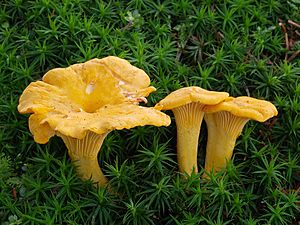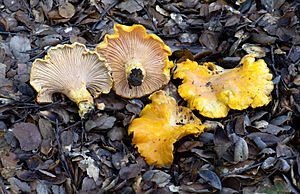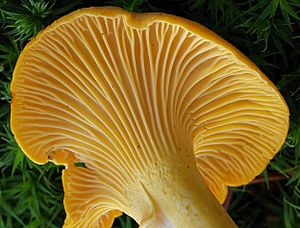Cantharellus facts for kids
Quick facts for kids Cantharellus |
|
|---|---|
 |
|
| Cantharellus cibarius | |
| Scientific classification |
|
| Kingdom: | Fungi |
| Division: | Basidiomycota |
| Class: | Agaricomycetes |
| Order: | Cantharellales |
| Family: | Cantharellaceae |
| Genus: | Cantharellus Adans. ex Fr. |
| Type species | |
| Cantharellus cibarius Fr.
|
|
| Cantharellus spp. | |
|---|---|
| Mycological characteristics | |
| ridges on hymenium | |
| cap is infundibuliform | |
| hymenium is decurrent | |
| stipe is bare | |
| spore print is yellow | |
| ecology is mycorrhizal | |
| edibility: choice or edible | |
Cantharellus is a group of popular edible mushrooms. They are often called chanterelles. This name can also refer to the most common type, Cantharellus cibarius.
Chanterelles are special fungi because they form a team with plants. This team-up is called a symbiotic relationship. It means they help each other grow. Because of this, it's very hard to grow chanterelles on farms.
It's important to be careful when picking chanterelles to eat. Some other mushrooms look like them but can make you very sick. For example, the Jack-O-Lantern mushroom is dangerous. Even with this risk, chanterelles are one of the most famous and picked edible mushrooms.
Many chanterelle types have good things for your body. They contain antioxidants called carotenoids. These are like beta-carotene found in carrots. They also have a lot of vitamin D.
The name "Cantharellus" comes from the Greek word kantharos. This word means "tankard" or "cup." It describes the mushroom's shape.
Contents
About Chanterelle Mushrooms
Where Chanterelles Grow
Cantharellus mushrooms grow all over the world. They are found in Africa, Europe, Asia, North America, South America, and Australia. They always grow near their plant partners.
Chanterelles like to grow near certain trees. These can be conifer trees or hardwood trees. In places like California and Texas, they often grow with oak trees.
In Scotland, you might find them in forests with silver birch and Scots pine. They especially like moist, mossy areas. In Fife, they are common under beech trees. You can often find them where wild blueberries grow too. In Spain, they team up with sweet chestnut trees.
The best time to look for chanterelles is from late July through the Autumn. A walk in the woods after it rains can be very rewarding. In coastal forests of Washington and British Columbia, they are often found in damp, mossy areas near Western hemlock trees.
Cooking with Chanterelles
Chanterelles are very tasty mushrooms. They go well with many foods. You can eat them with eggs, curry, chicken, pork, fish, beef, and veal.
They are great as toppings on pizzas. You can also stew them, marinate them, or sauté them. They make a good filling for stuffed crêpes. Chanterelles are very flexible and can be added to most dishes.
In European cuisine, chanterelles are often served with venison. A classic way to cook them is to sauté them first. Then, they are used to make delicious scrambled eggs.
In Poland, people use chanterelles to make creamy sauces. These sauces are often served over chicken.
Many mushroom lovers enjoy chanterelles simply sautéed in butter. They add a little salt, fresh crushed garlic, and some whipping cream. This way of cooking brings out their gentle flavor. It also helps them keep their taste even when frozen.
Chanterelles are a special part of Viennese cuisine.
How to Prepare and Store Chanterelles
Chanterelles hold a lot of water. So, people often cook them using a "dry sauté" method. First, clean and slice the mushrooms. Then, put them in a covered pan over high heat. Do not add oil or butter.
The mushrooms will release their water. You can let this water boil away. Or, you can pour it off and use it as a flavorful broth. Many people like to cook them with butter because it makes them taste sweeter.
You can also store chanterelles by pickling them in brine. Boil salted water and add pickling spices. These can include peppercorns, mustard seeds, and thyme. Cook the mushrooms in this liquid for 5–10 minutes.
Then, put them into sterilized bottles with some of the liquid. You can add sliced garlic and dill for more flavor. The leftover liquid makes a great stock for soup. Pickled chanterelles can last for six to twelve months.
Another way to store them is by drying them. You can dry mushrooms with gentle heat in an oven. The temperature should be 65 °C (149 °F) or less. For large amounts, a vacuum process works well.
A few hours before you want to use dried mushrooms, put them in water. They will soak up the water and return to almost their original size. Then, you can use them as if they were fresh. Dried mushrooms can last for a very long time.
Fresh chanterelles can usually be kept for up to ten days in a refrigerator.
Mushrooms That Look Like Chanterelles
It's important to know the difference between chanterelles and other mushrooms.
- The False Chanterelle (Hygrophoropsis aurantiaca) looks similar. It has thinner, more orange gills and a darker cap. You can eat it, but it doesn't taste as good as a real chanterelle.
- The Jack O'Lantern mushroom (Omphalotus olearius) and its relatives (like Omphalotus olivascens) are very poisonous. They won't kill you, but they will make you very sick. They have true gills, which are thinner and more distinct than chanterelles' ridges. Also, Jack-O-Lantern mushrooms glow in the dark (bioluminescent) and grow on wood. Chanterelles grow on the ground.
- Other mushrooms in the groups Craterellus, Gomphus, and Polyozellus might also look a bit like chanterelles. Always be sure before you pick and eat any wild mushroom!
See also
 In Spanish: Cantharellus para niños
In Spanish: Cantharellus para niños




